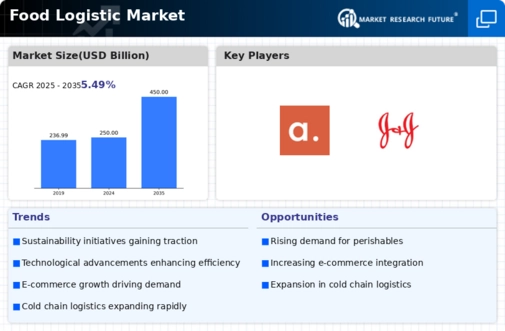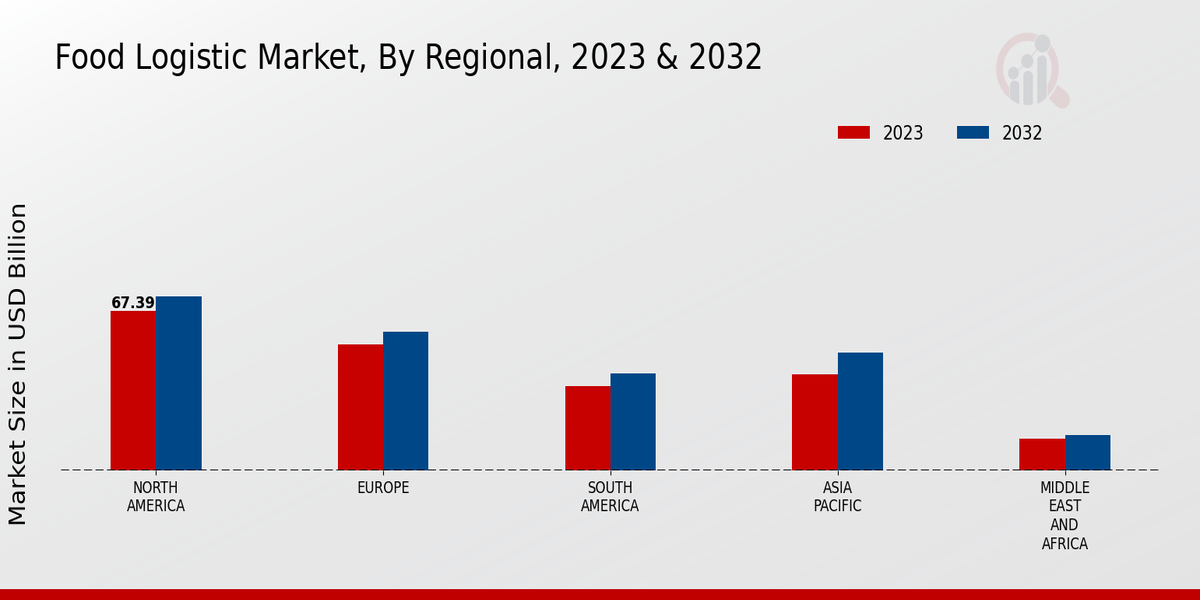Market Growth Projections
The Global Food Logistic Market Industry is poised for substantial growth, with projections indicating a market size of 250 USD Billion in 2024 and an anticipated increase to 450 USD Billion by 2035. This growth reflects a compound annual growth rate (CAGR) of 5.49% from 2025 to 2035. Factors driving this expansion include rising consumer demand for fresh produce, advancements in logistics technology, and the increasing importance of regulatory compliance. As the industry evolves, it is likely to adapt to changing consumer preferences and technological advancements, positioning itself for continued success in the global marketplace.
Rising Demand for Perishable Goods
The Global Food Logistic Market Industry experiences a notable increase in demand for perishable goods, driven by changing consumer preferences towards fresh and organic products. This trend is evident as consumers increasingly prioritize quality and freshness, leading to a surge in the transportation of fruits, vegetables, and dairy products. As a result, logistics providers are adapting their supply chains to ensure timely delivery, which is crucial for maintaining product integrity. The market is projected to reach 250 USD Billion in 2024, reflecting the growing importance of efficient logistics in meeting consumer expectations.
Technological Advancements in Logistics
Technological innovations play a pivotal role in shaping the Global Food Logistic Market Industry. The integration of advanced technologies such as IoT, AI, and blockchain enhances supply chain visibility and efficiency. For instance, IoT devices enable real-time tracking of shipments, ensuring optimal temperature control for perishable items. Additionally, AI-driven analytics facilitate demand forecasting, allowing logistics companies to optimize inventory levels. These advancements not only improve operational efficiency but also reduce waste, which is critical in the food sector. As the market evolves, these technologies are likely to drive growth, contributing to a projected CAGR of 5.49% from 2025 to 2035.
Sustainability Initiatives in Food Logistics
Sustainability initiatives are becoming a focal point in the Global Food Logistic Market Industry. As environmental concerns rise, logistics companies are adopting eco-friendly practices to reduce their carbon footprint. This includes optimizing transportation routes, utilizing energy-efficient vehicles, and implementing sustainable packaging solutions. For instance, some companies are transitioning to electric vehicles for deliveries, which not only lowers emissions but also appeals to environmentally conscious consumers. These sustainability efforts are likely to enhance brand loyalty and attract new customers, contributing to the industry's projected growth trajectory towards 450 USD Billion by 2035.
Regulatory Compliance and Food Safety Standards
The Global Food Logistic Market Industry is significantly influenced by stringent regulatory compliance and food safety standards. Governments worldwide are implementing rigorous regulations to ensure food safety and quality, necessitating logistics providers to adhere to these guidelines. For example, the FDA in the United States mandates specific temperature controls during transportation to prevent spoilage. Compliance with these regulations not only safeguards public health but also enhances the reputation of logistics companies. As the industry adapts to these evolving standards, the emphasis on safety and compliance is expected to drive market growth, particularly as the sector approaches a valuation of 450 USD Billion by 2035.
Growth of E-commerce and Online Grocery Shopping
The rise of e-commerce and online grocery shopping is reshaping the Global Food Logistic Market Industry. Consumers increasingly prefer the convenience of ordering groceries online, prompting logistics companies to develop specialized delivery solutions. This shift has led to the emergence of last-mile delivery services tailored for food products, ensuring rapid and efficient distribution. As a result, logistics providers are investing in infrastructure and technology to meet the demands of this growing segment. The market's expansion is evident as it is projected to reach 250 USD Billion in 2024, with e-commerce playing a crucial role in driving this growth.














Leave a Comment